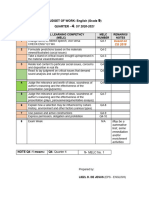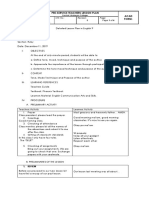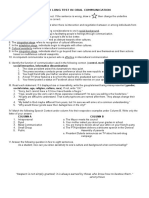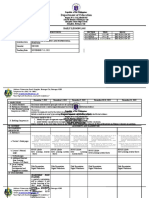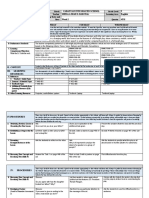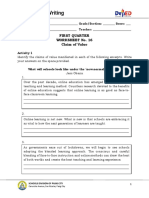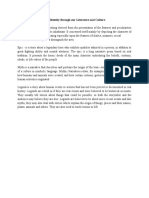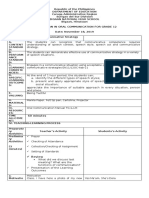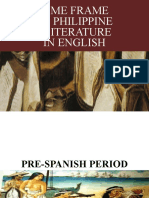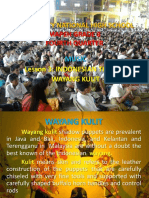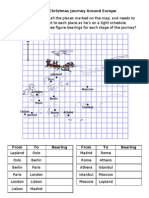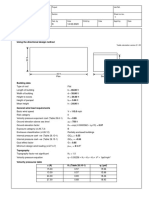EAPP - Q3 - Module 1 - Activity Sheet
Uploaded by
Kimberly Ann AsuncionEAPP - Q3 - Module 1 - Activity Sheet
Uploaded by
Kimberly Ann AsuncionRepublic of the Philippines
Department of Education
Region I
Schools Division of Ilocos Norte
Brgy. 6, Tonoton, Piddig, Ilocos Norte, Phils. 2912
Tel. #: 077-600-5148 / 077-600-5052 “Where Learning
/PiddigNHS.Official [email protected]
is for Life”
0 ENGLISH FOR ACADEMIC AND PROFESSIONAL PURPOSES
LEARNING ACTIVITY SHEET 1
QUARTER 3
TOPIC: Academic Language used from Various Disciplines
MELC: Differentiates language used in academic texts from various disciplines.
(CS_EN11/12A-EAPP-Ia-c-2)
LAS 1: SCORES
Name:___________________________________________________
WRITTEN WORKS: _______
Grade and Section:________________________________________
Date Submitted:___________________________________________ PERFORMANCE TASK: _______
An academic text is a reading material that provides information which include concepts and
theories that are related to the specific discipline. Common text includes introduction, body, and
conclusion. On one hand, students who master academic language are more likely to be successful in
academic and professional settings.
EASY LEVEL: Exploring Academic Text
Directions: Write TRUE if the statement is correct and FALSE if is not.
________1. Students who master academic language are more likely to be successful in academic and
professional settings.
________2. An academic text makes use of complex jargons to promote a higher level of comprehension.
________3. Academic text uses words which tones up claims expressing certainty.
________4. Both academic and non-academic texts can be used to inform.
________5. The language used in academic texts should be conversational.
________6. In reading an academic text, it helps acquire new information.
________7. An academic text needs less concentration and focus because the terms are simple.
________8. It is in academic text that issues are stated to provoke information discussion.
________9. A magazine is an academic text.
________10. Academic language should be objective, precise, impersonal and formal.
AVERAGE LEVEL: Academic Text vs. Non-Academic Text
Directions: Categorize the information based on their characteristics below by filling in the table to
differentiate academic text from non-academic text.
Characteristics
Everyday Events To Academic Text
inform and/or validate idea Non-Academic
To entertain Text
Scholarly
Audience audience
Related literature Contains slang and colloquialisms Subjective
Research papers, Reports Introduction-Body-Conclusion No fixed structure
Purpose
Public Diaries, Informal essays Formal Objective
Structure
Language
|1
Style
Source of content
Examples
DIFFICULT LEVEL: Evaluating an Academic Text
Directions: Using the criteria given, evaluate the language of the following sample academic texts from
various disciplines.
A. This essay intends to investigate whether there is a causal relationship between music listened to
and the mood of individuals. Additionally, it will seek to explore whether this relationship is used in
advertising to encourage people to spend money.
B. This essay intends to investigate whether there is a causal relationship between music listened to
and the mood of individuals. Additionally, it will seek to explore whether this relationship is used in
advertising to encourage people to spend money.
C. This essay intends to investigate whether there is a causal relationship between music listened to
and the mood of individuals. Additionally, it will seek to explore whether this relationship is used in
advertising to encourage people to spend money.
D. This essay is focused on investigating the photo tactic responses of three different species of fish
that occupy different areas of an aquarium: danios (Danio rerio), which group near the surface of
the water, black skirt tetra (Gymnocorymbus ternetzi), which swim in the middle of the tank, and
kuhli loach (Pangio kuhlii), which swim near the bottom of tank. It is anticipated that they will
respond differently to light according to their niche with the tank.
E. This essay is focused on investigating the photo tactic responses of three different species of fish
that occupy different areas of an aquarium: danios (Danio rerio), which group near the surface of
the water, black skirt tetra (Gymnocorymbus ternetzi), which swim in the middle of the tank, and
kuhli loach (Pangio kuhlii), which swim near the bottom of tank. It is anticipated that they will
respond differently to light according to their niche with the tank.
Characteristics of Academic Language A B C D E
Does the text use a formal language? (Yes/No)
Is the language impersonal? (Yes/No)
Are the choice of words appropriate for an academic text? (Yes/No)
Does the text use technical terms? (If yes, write 1 term found in the
text./No)
Is the academic text objective? (Yes/If No, write 2 phrases that
indicate subjectivity.)
Republic of the Philippines
SIGNATURE OF STUDENT: ______________________ SIGNATURE OF PARENTS: __________________
Department of Education
Region I
Schools Division of Ilocos Norte
Brgy. 6, Tonoton, Piddig, Ilocos Norte, Phils. 2912
Tel. #: 077-600-5148 / 077-600-5052 “Where Learning
/PiddigNHS.Official [email protected]
is for Life”
0
ENGLISH FOR ACADEMIC AND PROFESSIONAL PURPOSES
LEARNING ACTIVITY SHEET 2
|2
QUARTER 3
TOPIC: Text Structure
MELC: Uses knowledge of text structure to glean the information he/she needs
(CS_EN1/12A-EAPP-Ia-c-4)
LAS 2: SCORES
Name:___________________________________________________
WRITTEN WORKS: _______
Grade and Section:________________________________________
Date Submitted:___________________________________________ PERFORMANCE TASK: _______
Text structures (WDPI, 2012) refer to the way authors organize information in text.
Recognizing the underlying structure of texts can help students focus attention on key concepts and
relationships, anticipate what is to come, and monitor their comprehension as they read.
Narrative: narrates an event or a story.
Chronological: information in the passage is organized in order of time.
Cause and Effect: the results of something are explained
Problem and Solution: a problem is described and a response or solution is proposed or
explained
Compare and Contrast: two or more things are described. Their similarities and differences are
discussed.
Definition/Description: Describes a topic by listing characteristics, features, attributes, and
examples.
EASY LEVEL: Identifying Text Structures
Directions: Identify the text structure based on the given statement.
________________1.This text structure is “how are things in the text similar or different.
________________2.The text structure that discusses what is specifically being described.
________________3. The text structure that is written in a style that tells what happened and why it
happens.
________________4.This text structure tells what the conflict is, or problem, and how it was solved.
________________5.The text structure that shows events taking place over time or gives steps is…
________________6. “Similar, same, alike, both, on the other hand, instead” are signal words for…
________________7.Before putting the model car together, we gathered our supplies. Then we were able
to read and follow the directions. Before long, our car was done.
________________8.Which type of text structure answers the question of what happened and why?
________________9.Which type of text structure shows how two or more things are alike and different?
________________10.The sentence structure that narrates a story.
AVERAGE LEVEL: Determining Passage Sentence Structure
Directions: Read the passages and determine what sentence structure is used. Choose your answer from
the list of words below. Write only the letter of your choice.
A. Narrative B. Chronological/Sequence C. Cause-Effect
D. Descriptive E. Problem-Solution F. Compare-Contrast
|3
________1. There are two popular sports played at Milton, basketball, and volleyball. Both take place
inside of the gym at Milton. Also, each sport has two teams of people. In basketball, however, the ball can
be played off of the floor, and in volleyball, the ball cannot touch the floor, or it is out of play. Basketball and
volleyball are popular sports at Milton. What text structure is this?
________2. Lots of students fail classes. Some students fail because the work is too hard for them. Other
times they may fail because they are lazy, and don’t do any work. Another reason why students may fail is
if they don’t go to school. If you’re not in class, you may miss a lot. Many students fail classes every
quarter. What text structure is this?
________3. Dr. Knapp doesn’t want people to sit back and let the toad vanish. He believes that everyone is
responsible for restoring the toad species. Dr. Knapp thinks we could help restore the toad population if we
stop mowing parts of our lawns and let the grass grow wild to reserve space for the toad. He also believes
we need to stop using pesticides and fertilizers. The chemicals kill the insects that toads eat. If we preserve
some spaces in our lawns and stop using fertilizers, Dr. Knapp believes we can save the toads. What text
structure is this?
________4. Devers experienced the highlight of any sprinter’s career, as she stood on the huge platform in
the giant stadium and received an Olympic gold medal. Eighteen months earlier she wasn’t thinking about
running. She was hoping that she would be able to walk again. Just four years earlier, in the summer of
1988, as Devers was training for the Olympic Games, to be held in Seoul, South Korea, she began to feel
very tired all the time and failed to make the Olympic finals. What text structure is this?
________5. The Eiffel Tower is divided into three sections. I. The lowest section of the tower contains the
entrance, a gift shop, and a restaurant. II. The middle section of the tower consists of stairs and elevators
that lead to the top. III. The top section of the tower includes an observation deck with a spectacular view of
Paris.
DIFFICULT LEVEL: Academic Writing using Text Structure
Directions: Write an essay about your experience during the COVID -19 pandemic using a specific text
structure of your choice.
Text Structure:
_________________________________________________________________
Title:__________________________________________________________________________
______________________________________________________________________________
______________________________________________________________________________
______________________________________________________________________________
______________________________________________________________________________
______________________________________________________________________________
______________________________________________________________________________
______________________________________________________________________________
______________________________________________________________________________
______________________________________________________________________________
______________________________________________________________________________
______________________________________________________________________________
______________________________________________________________________________
______________________________________________________________________________
______________________________________________________________________________
______________________________________________________________________________
______________________________________________________________________________
______________________________________________________________________________
______________________________________________________________________________
______________________________________________________________________________
|4
______________________________________________________________________________
______________________________________________________________________________
______________________________________________________________________________
______________________________________________________________________________
______________________________________________________________________________
______________________________________________________________________________
______________________________________________________________________________
______________________________________________________________________________
______________________________________________________________________________
______________________________________________________________________________
______________________________________________________________________________
______________________________________________________________________________
______________________________________________________________________________
______________________________________________________________________________
______________________________________________________________________________
______________________________________________________________________________
______________________________________________________________________________
______________________________________________________________________________
______________________________________________________________________________
______________________________________________________________________________
______________________________________________________________________________
______________________________________________________________________________
RUBRIC FOR ESSAY
SIGNATURE OF STUDENT: ______________________ SIGNATURE OF PARENTS: __________________
Republic of the Philippines
Department of Education
Region I
Schools Division of Ilocos Norte
Brgy. 6, Tonoton, Piddig, Ilocos Norte, Phils. 2912
Tel. #: 077-600-5148 / 077-600-5052 “Where Learning
/PiddigNHS.Official [email protected]
is for Life” |5
0
ENGLISH FOR ACADEMIC AND PROFESSIONAL PURPOSES
LEARNING ACTIVITY SHEET 3
QUARTER 3
TOPIC: Techniques in Summarizing Variety of Academic Texts
MELC: Uses various techniques in summarizing a variety of academic texts.
(CS_EN11/12A-EAPP-Iac-4)
Name:___________________________________________________ LAS 3: SCORE:
Grade and Section:________________________________________
Date Submitted:___________________________________________
A summary is a short overview of an entire discussion or argument. You might summarize a
whole research paper or conversation in a single paragraph, for example, or with a series of bullet points,
using your own words and style. People often summarize when the original material is long, or to
emphasize key facts or points. Summaries leave out details or examples that may distract the reader
from the most important information, and they simplify complex arguments, grammar and vocabulary.
Techniques:
Somebody Wanted But So: helps students generalize, recognize cause and effect relationships,
and find main ideas.
SAAC Method: acronym for “State, Assign, Action, Complete.”
5 W's, 1 H: relies on six crucial questions: who, what, when where, why, and how.
First Then Finally: helps students summarize events in chronological order.
Give Me the Gist: like giving a friend the gist of a story; not a retelling of every detail.
ACTIVITY: Summarizing a Text
Directions: Read the text below. Write a 3-5 sentence summary of the following text using any of the
techniques.
Understanding Calories
I. A calorie, also known as kilocalorie, is a unit of energy. This unit represents the energy required to
heat a kilogram of water on degree Celsius. While people generally Link the term calorie with food,
it is a unit of measurement that can be applied to any substance possessing energy. For instance,
there are 8200 calories in a litter (about one quart) of gasoline.
II. Calories describe the potential energy in food to maintain bodily functions, grow or repair tissue, and
perform mechanical work such as exercise. Food calories may take the form of fat, carbohydrates,
or proteins. Once consumed, enzymes act on these nutrients through metabolic processes and
break them into their perspective categories of fatty acids, glucose, and amino acids. These
molecules travel through the blood stream to specific cells where they are absorbed for immediate
use or sent on to the final stage of metabolism where they release their stored energy through the
process of oxidation.
III. The number of calories burned during an exercise depends on various factors including body weight
and the type of exercise. For example, an individual weighing 59 kilograms (130 pounds) would
|6
expend roughly 500calories per hour swimming or playing basketball. However, this same person
would burn an estimated 200 walking or playing table tennis. In order to survive and maintain body
weight, the average individual requires approximately 2000 to 2500 calories per day. Gaining or
losing weight is a simple process. Add and subtract 7,700 calories over the course of time to gain or
lose a kilogram. Nutrition has nothing to do with it. It is all about calories.
Technique: ______________________________________________________________
Summary:________________________________________________________________
_________________________________________________________________________
_________________________________________________________________________
_________________________________________________________________________
_________________________________________________________________________
_________________________________________________________________________
_________________________________________________________________________
_________________________________________________________________________
_________________________________________________________________________
_________________________________________________________________________
_________________________________________________________________________
_________________________________________________________________________
_________________________________________________________________________
_________________________________________________________________________
_________________________________________________________________________
_________________________________________________________________________
_________________________________________________________________________
_________________________________________________________________________
SIGNATURE OF STUDENT: ______________________ SIGNATURE OF PARENTS: __________________
|7
You might also like
- 21st Century Literature From The Philippines and The World: Introduction To Philippine LiteratureNo ratings yet21st Century Literature From The Philippines and The World: Introduction To Philippine Literature14 pages
- Region 02: The Learner Produces A Detailed Abstract of Information Gathered From The Various Academic Texts ReadNo ratings yetRegion 02: The Learner Produces A Detailed Abstract of Information Gathered From The Various Academic Texts Read6 pages
- Malade LP ENG9-tone, Mood, Technique and Authors PurposeNo ratings yetMalade LP ENG9-tone, Mood, Technique and Authors Purpose6 pages
- SUMMATIVE TEST IN Eapp For Signature Tomam DinNo ratings yetSUMMATIVE TEST IN Eapp For Signature Tomam Din6 pages
- Republic of The Philippines Division of Bohol Department of Education Region VII, Central VisayasNo ratings yetRepublic of The Philippines Division of Bohol Department of Education Region VII, Central Visayas7 pages
- Reading and Writing: First Quarter Worksheet No. 16 Claim of ValueNo ratings yetReading and Writing: First Quarter Worksheet No. 16 Claim of Value5 pages
- Demo - Delivering A Self Composed SpeechNo ratings yetDemo - Delivering A Self Composed Speech34 pages
- Lesson 3 - USE VARIOUS TECHNIQUES IN SUMMARIZING A VARIETY OF ACADEMIC TEXTSNo ratings yetLesson 3 - USE VARIOUS TECHNIQUES IN SUMMARIZING A VARIETY OF ACADEMIC TEXTS31 pages
- Grade 12 Creative Writing Test QuestionsNo ratings yetGrade 12 Creative Writing Test Questions4 pages
- Detailed Lesson Plain in Character Education 7No ratings yetDetailed Lesson Plain in Character Education 711 pages
- Semi-Detailed Lesson Plan in English For Academic and Professional PurposesNo ratings yetSemi-Detailed Lesson Plan in English For Academic and Professional Purposes22 pages
- Dlp-Differences of Academic and Literary Writing Day 2No ratings yetDlp-Differences of Academic and Literary Writing Day 26 pages
- Department of Education: Budget of Work in Grade 9 English100% (1)Department of Education: Budget of Work in Grade 9 English1 page
- Schola de San Jose: Cannery Road, Polomolok, South Cotabato, Philippines, 9504No ratings yetSchola de San Jose: Cannery Road, Polomolok, South Cotabato, Philippines, 95042 pages
- Valuing Others and Their Circumstances: I. ObjectivesNo ratings yetValuing Others and Their Circumstances: I. Objectives3 pages
- Appreciating The Filipino Identity Through Our Literature and CultureNo ratings yetAppreciating The Filipino Identity Through Our Literature and Culture3 pages
- Eng9 Types of Information Disorders 04.03.23 DENSINGNo ratings yetEng9 Types of Information Disorders 04.03.23 DENSING17 pages
- I. Objectives: Define Intimate Communicative StyleNo ratings yetI. Objectives: Define Intimate Communicative Style5 pages
- A.K12 - FINAL Management Brain Tumors Dr. Dr. Rr. Suzy Indharty, M. Kes, SP - BsNo ratings yetA.K12 - FINAL Management Brain Tumors Dr. Dr. Rr. Suzy Indharty, M. Kes, SP - Bs42 pages
- WAYANG KULIT INDONESIAN THEATER Ppt. (By Sir Alivia)100% (1)WAYANG KULIT INDONESIAN THEATER Ppt. (By Sir Alivia)23 pages
- Critically Assess Whether Marx's Concept of Alienation' Is Still Useful in Explaining How Employees' Experience Work in Contemporary SocietiesNo ratings yetCritically Assess Whether Marx's Concept of Alienation' Is Still Useful in Explaining How Employees' Experience Work in Contemporary Societies8 pages
- Directional Method - Flat Roof With Parapet ExampleNo ratings yetDirectional Method - Flat Roof With Parapet Example6 pages
- Detailed Lesson Plan (DLP) Format Date: - Section/sNo ratings yetDetailed Lesson Plan (DLP) Format Date: - Section/s3 pages
- Instant Download Postharvest disinfection of fruits and vegetables Siddiqui PDF All Chapters100% (1)Instant Download Postharvest disinfection of fruits and vegetables Siddiqui PDF All Chapters41 pages
- Division Memo. No. 139 s. 2025 Division Implementation of 2025 Brigada Eskwela Program100% (1)Division Memo. No. 139 s. 2025 Division Implementation of 2025 Brigada Eskwela Program36 pages
- Sickle Cell Mutation Extension v2 (2) (2)No ratings yetSickle Cell Mutation Extension v2 (2) (2)2 pages
- Pgmp Exam Challenge Ginger Levin J Leroy Ward downloadNo ratings yetPgmp Exam Challenge Ginger Levin J Leroy Ward download83 pages
- Get Instant Solutions to Mathematical Problems on Your iPhone or iPad with Apple's New Math Notes __ Apple __ Gadget HacksNo ratings yetGet Instant Solutions to Mathematical Problems on Your iPhone or iPad with Apple's New Math Notes __ Apple __ Gadget Hacks19 pages
- This Study Resource Was: D Profit TR TC Profit $ 37,500No ratings yetThis Study Resource Was: D Profit TR TC Profit $ 37,5004 pages


